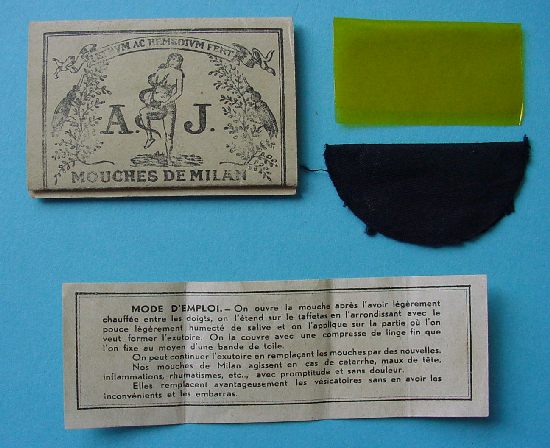|
In addition to bloodless and bloody bloodletting, in which blood is "displaced", deriving methods include "white cupping" with cantharvic plasters. Accumulations of "unhealthy body fluids" from the inside of the body are locally conducted to the surface and disposed of there. In this method, therefore, light SERUM is removed, hence the term "white bloodletting".
The Kantharide, "mouche d'Espagne" or "mouche de Milan" [eng. "Spanish fly"] is a beetle native to Central Europe and the countries of the Mahgreb. From it, a powder is produced which, when applied to human skin, causes inflammation comparable to a blast of blast. In this method, already known in ancient times, a lovely ointment is applied to the skin, whereupon a blister forms, as in a 2nd degree burn. The doctor stabs this bladder (preferably sterile) using either a knife or a syringe. Then the skin is covered with a sterile bandage - like a burn.
Kantharidenpflaster.
(Blister plaster, Spanish fly plasters, Emplastrum cantharidum [vesicatorium] ordinarium), a mixture of 2 parts coarsely powdered Spanish flies (Kanthariden), 1 part olive oil, 4 parts yellow wax and 1 part turpentine; is soft, is painted on canvas with a knife back and attached to the skin with adhesive plaster; it draws a bubble in 6-12 hours. The lymphatic flow is stimulated, good results are achieved in many chronic complaints of the joints - knee osteoarthritis, hip osteoarthritis, blockages of the cervical and lumbar spine. Cave: in kidney patients !!
History to the method
The external discharge is already documented by doctors in ancient India. Here, the bladder (Vesikation) was deliberately brought about by mixing ash with caustic lye and applied to the skin. Also in the Roman Empire and in the Arab medicine one worked with this therapy. However, the external application of the Kantharids as vesikans was scarcely in use before the Middle Ages, and from then on it was increasingly used against a large number of painful and inflammatory conditions. Paracelsus praised it as a remedy in the case of gout: "Where nature creates a pain there, she wants to accumulate and emptying harmful substances, and if she does not do it herself there, make a hole in the skin and let it out" (Paracelsus).
The internal use as an aphrodisiac was also already known to the ancient Greeks. The "Canossa-goer" King Henry IV (1050-1106) is said to have consumed Kantharidenpulver against his potency problems. The Marquis de Sade rewarded his whores with anishaltigen pearls, in which Kantharidenpulver was included. When one of these ladies died of Kantharidin intoxication, the horny Marquis had to flee, was picked up and arrested ...
Here is the recipe of the pharmacist GAROSTE from Fos:
Poix noire purifiée ............... 125 grams
Cire blanche ........................ 30 grams
Cantharides en poudre fine ... 60 grams
Essence de Térébenthine ...... 15 grams
Huile d'Olives ....................... 8 grams
exhibit
Presented is a plaster note, acquired on April 22, 2007 in Steinfort. The same product in a round cardboard box from a Parisian pharmacy (Ebay 6/2018).
|




